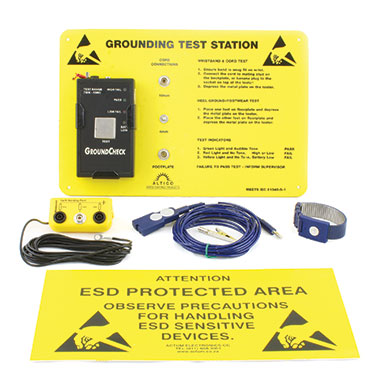

ESD stands for electrostatic discharge, and describes the transfer of electrostatic charge between two objects. The resulting discharge from an electron imbalance may be so small that the human body cannot feel it, nevertheless it can have serious consequences. In electronics manufacturing, pharmaceuticals, healthcare, ordnance manufacturing and storage, ESD incidents can often cause material, component, or system failures, which may prove costly and sometimes even dangerous.
The importance of testing
Since static charge cannot be seen and since the human body cannot always detect or feel harmful electrostatic discharges, regular testing and monitoring is the only way of knowing for sure whether your facility is safe or at risk.
The first step is to establish an ESD Protected Area (EPA), which is essentially a cordoned-off area and controlled environment where components and devices that are vulnerable to ESD damage are safely handled. Once you have identified an EPA and the equipment required to control static within this environment, you need to establish a documented testing and monitoring system which outlines the items to be tested, as well as the frequency. It is always advisable to keep a record of all tests conducted as well as the results so that you can refer back to it if necessary.
Types of testing equipment
There are various types of testers but the following are some of the most popular ones required by almost any EPA:
• Field meters: portable static detectors that measure the static of all moving objects. This is especially useful when setting up the EPA or when working on site, and helps determine objects and areas that are generating the most static.
• Ground-check tester: this tester contains two probes that can be placed on either side of an object to measure its resistance. This is useful to determine whether you are operating with the correct ESD resistivity standards governing your industry and application.
• Footwear and wrist-strap testers: grounding forms a critical part of effective static control since movement is a major generator of static charge. Personnel grounding equipment, such as wrist straps and footwear, need to be monitored continuously while they are working directly with ESD-sensitive components.
Calibration of testing equipment
All testers need to be calibrated once a year to ensure that they are functioning within the correct test range and are compliant with ESD standards. Different industries and applications have different ESD compliance standards and so the equipment needs to measure within the correct static and resistivity ranges as well.
| Tel: | +27 11 608 3001 |
| Email: | [email protected] |
| www: | www.actum.co.za |
| Articles: | More information and articles about Actum |

© Technews Publishing (Pty) Ltd | All Rights Reserved